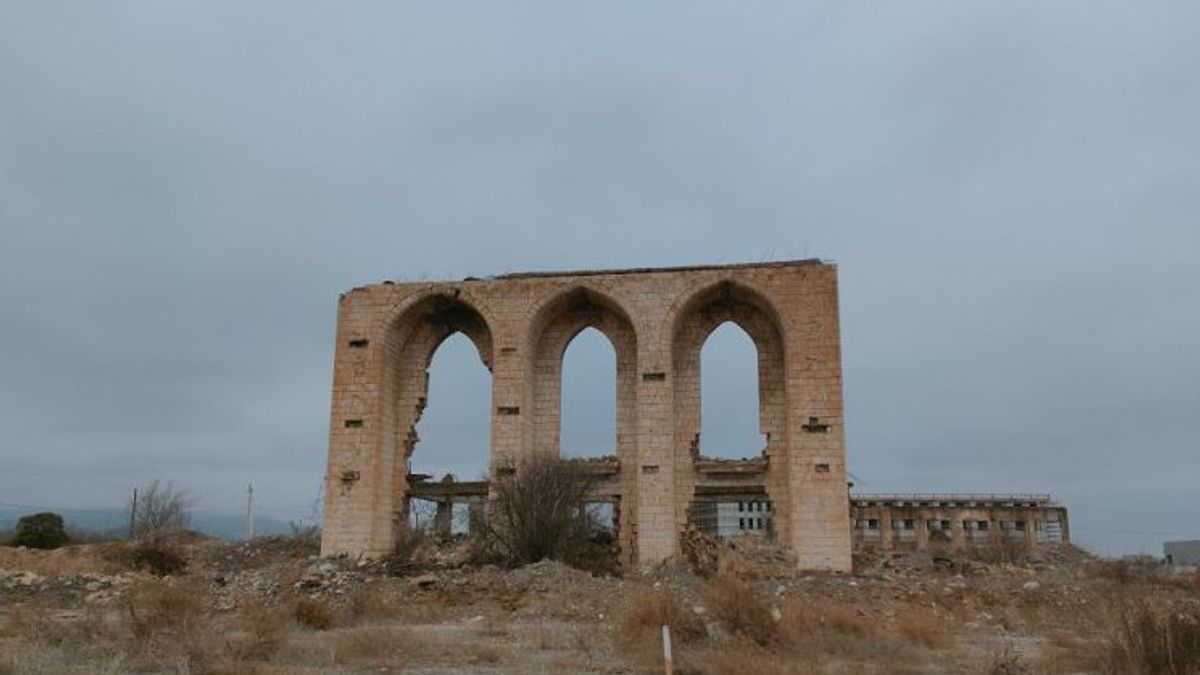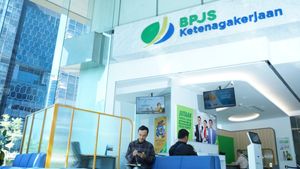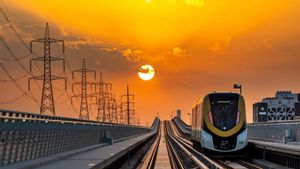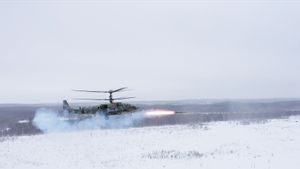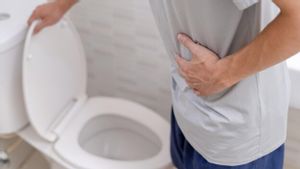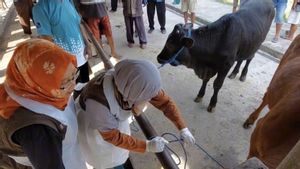JAKARTA - Away from the hustle and bustle of the Azerbaijani capital, Baku, the ruins of buildings in Aghdam stand frail, tired of being witnesses to the history of the conflict between Azerbaijan and Armenia.
Many of the walls of the buildings are perforated, roofless, even almost collapsing and look dull with age.
Rows of wrecked old cars, piles of crumbling walls, and piles of sand can be found in various corners of the city that were once known as one of the largest and most beautiful districts in Azerbaijan.
As a result of the conflict, the beauty of the city named Aghdam, which means small palace in ancient Turkish, was left untouched.
The district, which has an area of approximately 1,154 km2, is now uninhabited, deserted, and desolate.
The district was forced out of existence due to military aggression by Armenia following the dissolution of the Soviet Union in 1991.
Before the occupation by the Armenians, heavy industry, snack food, and agriculture were developed in Aghdam.
Aghdam was involved in the first Karabakh war which broke out in 1988, according to Senior Advisor to the Special Representative of the President of Azerbaijan in the liberated part of the Karabakh Economic Area, Araz N. Imanov when he met ANTARA in Aghdam, Azerbaijan, some time ago.
The bloody war lasted until a ceasefire in 1994 saw Armenia occupy 20 percent of Azerbaijan's territory. More than 30,000 Azerbaijanis were killed, another million were driven from the land.
Armenian forces occupied most of Aghdam district, including the town and 89 villages, which account for about 73 percent of the district's area, on 23 July 1993.
The occupied area was razed to the ground. A small number of villages in Aghdam District remained under Azerbaijani control after the Armenian occupation, Imanov said.
During the 5 years of bloody fighting for the defense of Aghdam, 5,897 people died, 3,531 became disabled, and 1,871 children became orphans.
Thousands of people became physically disabled, more than 126 thousand (1993) Aghdam residents fled their homeland.
On July 29, 1993, the UN Security Council adopted resolution 853, based on the report of Mario Rafaelli, former Chair of the OSCE Minsk Group.
The resolution condemned the occupation of Aghdam, calling for the immediate, complete, and unconditional withdrawal of the occupying forces from the area and for the return of refugees to their homes.
Imanov said most of the monuments left in the occupied territories have been completely or partially destroyed
Museums have been looted, monuments and artefacts stolen and transported elsewhere.
Some of the museums that were destroyed, among others, the Museum of Bread, Museum of History and Geography, Museum of the famous performer Gurban Pirimov, and the Art Gallery.
The Juma Mosque, continued Imanov, an ancient architectural and religious monument in the city center of Aghdam – the only mosque in this district – was also badly damaged.
He said the ceiling was destroyed and wall inscriptions were completely erased at the Juma Mosque.
Due to the Armenian vandalism in 2008, Lonely Planet magazine referred to Aghdam as the "Hiroshima Caucasus", he said.
Imanov also said that dozens of cemeteries in Aghdam district were not spared from the destruction. The tombstone is crushed with a hammer or other similar object. Graves were dug up to find gold teeth from the bodies that had been buried.
While walking past one of the graves in Aghdam, he revealed all the graves were burnt before they (Armenians) left.
They dug in the grave, taking out the bones. This is another gravestone here, completely destroyed. This is what they do. They burned it before leaving. They burned all the graves. They also burned forests and buildings. This is an example of what they have done to all the Azerbaijani cemeteries in the Karabakh region, said Imanov.
Tombstones are even used to build staircases in Armenian homes.
Not only in Aghdam, tens of graves in Fuzuli, Zangilan, Kalbajar and Jabrayil districts were also destroyed by Armenian separatists.
Holding back tears, Imanov told me that his grandfather's grave, which was in the Fuzuli district, was burnt, vandalized and dug up. None of the bones of his late grandfather remained. Everything was destroyed without a trace.
He said the destruction of Azerbaijani graves was confirmed by thousands of photographs taken by photo journalists or foreign observers.
Back to the arms of Azerbaijan
After decades of Aghdam being occupied by Armenia, the city which means "white house" has finally returned to the bosom of Azerbaijan.
The occupation of Aghdam ended after 27 years as a result of a 6 week long war between Armenia and Azerbaijan in 2020.
On September 27, 2020, the decades-old conflict between the two countries escalated after Armenian troops deployed on occupied Azerbaijani lands shelled Azerbaijani military positions and civilian settlements.
Imanov said during the counterattack operation that lasted 44 days, Azerbaijani forces liberated more than 300 settlements, including the cities of Jabrayil, Fuzuli, Zangilan, Gubadli, and Shusha, from the illegal Armenian occupation of nearly 30 years.
The Second Karabakh War ended with a trilateral peace agreement between Russia, Azerbaijan and Armenia signed on 10 November 2020,
Under the agreement, Armenia also returned the occupied Aghdam, Kalbajar and Lachin districts to Azerbaijan. Aghdam is the first liberated postwar district of Azerbaijan defined by the document.
Shortly after the war, Imanov said the Azerbaijani government began extensive mine clearance operations on formerly occupied lands.
Mine operations, however, faced many challenges due to Armenia's refusal to hand over maps of the areas where the landmines were located.
In early 2021, Armenia submitted several minefield maps of the formerly occupied districts of Aghdam, Fuzuli, and Zangilan.
The maps are expected to help identify the coordinates of a total of 189,000 anti-tank and anti-personnel mines.
Imanov said Azerbaijan is currently clearing the area of landmines planted by Armenia.
After all the landmines have been removed, the people of Azerbaijan, who were expelled from their homeland due to the military aggression of Armenia, can return home.
Currently those who were expelled from their homeland as a result of the First Karabakh War live around the cities of Baku, Ganja and Sumqayit.
He said his party needed assistance, both financial and technological from all parties, both countries and international institutions to support the program to clear hundreds of thousands of landmines.
VOIR éGALEMENT:
Development
Imanov said the government is currently carrying out large-scale reconstruction and restoration works in Aghdam, Fuzuli, Shusha and other districts.
President Aliyev made a breakthrough by building a new highway and the first "smart" residential building.
A total of 1,750 houses and 23,000 apartments will reportedly be built in Aghdam. Seventy percent of city residents will live in apartment buildings, and the remaining 30 percent in private homes.
The Aghdam Bread Museum, world famous and the oldest school in the Karabakh region, launched in 1883 and destroyed during the occupation, will also be revived.
The city center will be rebuilt in line with the traditional architecture of Karabakh City.
There will also be a football stadium, city hall, theater, concert hall and Karabakh University.
A park with a memorial museum in honor of the victory in the Patriotic War and an open-air concert hall will also operate in the city.
Imanov said that now the Aghdam Conference Center is already standing magnificently, which was built in less than 2 months.
Ağhdam Conference Center is the first and only conference center in Karabakh, which has an area of 1400 m2.
Ağhdam Conference Center offers various options for conferences, seminars, business meetings, concerts and several other events.
In Fuzuli, he continued, Fuzuli International Airport has also been established.
Fuzuli International Airport is the first airport in the Karabakh region of Azerbaijan and will open in October 2021.
Fuzuli International Airport is the first airport in the Karabakh region, which was recently liberated from the Armenian occupation.
The airport will serve new international air routes, as part of the government's efforts to gain full control of air navigation systems and flights over the liberated areas, Imanov said.
The new international airport was inaugurated in the presence of the President of the Republic of Azerbaijan Ilham Aliyev and the President of the Republic of Turkey Recep Tayyip Erdogan, in October 2021.
The groundbreaking for the Azerbaijan airport took place in January 2021. An Airbus A340-500 passenger plane belonging to flag carrier Azerbaijan Airlines landed at the airport in September 2021, marking the completion of a test flight between Baku and Fuzuli, in approximately 35 minutes.
Built in 8 months, Fuzuli International Airport is Karabakh's gateway to the world.
The rebuilding of city centers in districts previously destroyed by war is being carried out by the Azerbaijani government, Imanov said.
He did not know exactly when the reconstruction and restoration would be finished.
However, Imanov is optimistic that the rebuilding of districts that were previously destroyed by the war can be completed as soon as possible.
Imanov's optimism is a reflection of the hope of the people of Azerbaijan, especially the refugees who want to return to their homeland.
Their houses may be destroyed, but the beautiful memories of their homeland will not be lost.
The English, Chinese, Japanese, Arabic, and French versions are automatically generated by the AI. So there may still be inaccuracies in translating, please always see Indonesian as our main language. (system supported by DigitalSiber.id)
